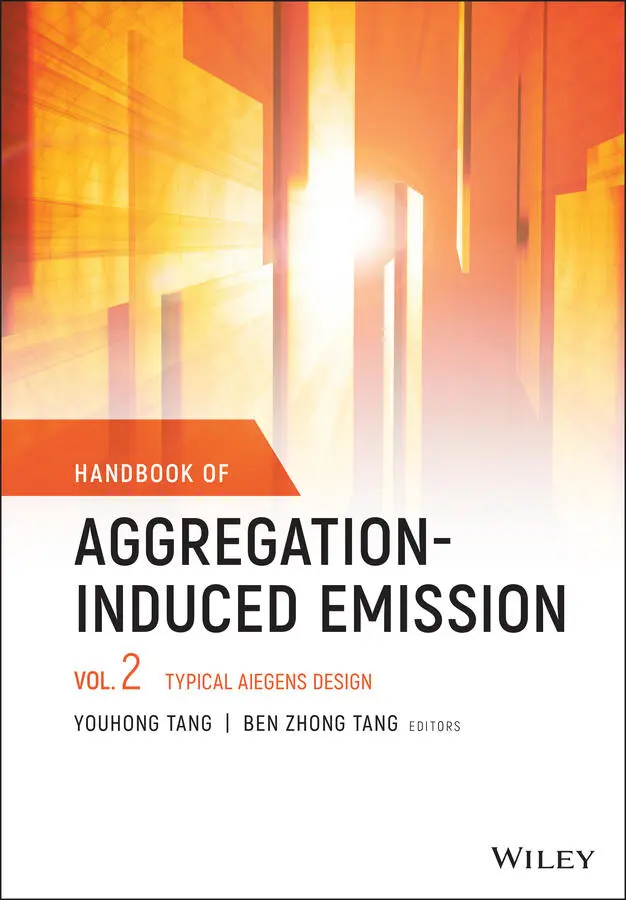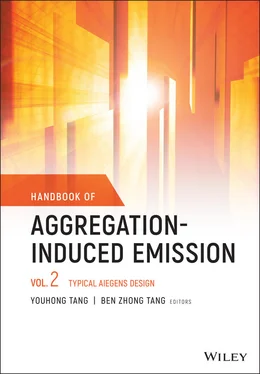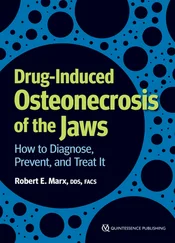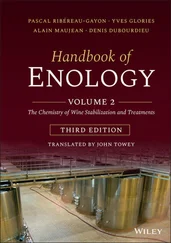
1 Cover
2 Title Page Handbook of Aggregation‐Induced Emission Volume 2 Typical AIEgens Design Edited by Youhong Tang Flinders University Adelaide, Australia Ben Zhong Tang The Chinese University of Hong Kong Shenzhen, China
Volume 2 Typical AIEgens Design
3 Copyright Page
4 Dedication Page
5 List of Contributors
6 Preface to Handbook of Aggregation‐Induced Emission
7 Preface to Volume 2: Typical AIEgens Design
8 1 Tetraphenylpyrazine‐based AIEgens: Synthesis and Applications 1.1 Introduction 1.2 Synthesis of TPP‐based AIEgens 1.3 Functionalities of TPP‐based AIEgens 1.4 Conclusion References
9 2 AIEgens Based on 9,10‐Distyrylanthracene (DSA): From Small Molecules to Macromolecules 2.1 Introduction 2.2 Application of AIE Luminogens Based on 9,10‐Distyrylanthracene 2.3 Conclusions and Outlook Acknowledgments References
10 3 Typical AIEgens Design: Salicylaldehyde Schiff Base 3.1 Introduction 3.2 Fluorescent Probes 3.3 Fluorescent Materials 3.4 Summary and Perspectives References
11 4 Diaminodicyanoquinodimethanes: Fluorescence Emission Enhancement in Aggregates and Solids 4.1 Introduction 4.2 Nonlinear Optical Materials based on DADQs 4.3 Enhanced Fluorescence in Aggregates and Solids Based on DADQs 4.4 Mechanistic Insights into the Enhanced Fluorescence 4.5 Impact of Crystallinity on the Fluorescence Response 4.6 Emergent and Potential Applications of DADQs 4.7 Concluding Remarks Acknowledgements References
12 5 Aggregation‐induced Emission from the Sixth Main Group 5.1 Introduction 5.2 Oxygen 5.3 Sulfur 5.4 Selenium and Tellurium 5.5 Conclusion Acknowledgment References
13 6 Fluorescence Detection of Dynamic Aggregation Processes Using AIEgens 6.1 Introduction 6.2 Selective Detection of Phase Transformation During Evaporative Crystallization of Hexaphenylsilole 6.3 Observation of the Initial Stage of Organic Crystal Formation During Solvent Evaporation Using a Cyanostilbene Derivative 6.4 Chemometrix Analysis of the Aggregated Structure of Cyanostilbene in a Reprecipitation Solution Using Fluorescence Excitation Spectroscopy 6.5 UV‐triggered Fluorescence Enhancement of a Dicyanostilbene Derivative Film Cast from an Ethanol Solution 6.6 Concluding Remarks Acknowledgments References
14 7 Cyclic Triimidazole Derivatives 7.1 Introduction 7.2 The Protoype: Cyclic Triimidazole 7.3 Halogenated Derivatives of Cyclic Triimidazole 7.4 Organic Derivatives 7.5 Hybrid Inorganic/Organic Derivatives 7.6 Conclusions Acknowledgments References
15 8 Synthesis of Multi‐phenyl‐substituted Pyrrole (MPP)‐based AIE Materials and Their Applications 8.1 Introduction 8.2 Modular Approach: Systematic Synthesis of MPPs 8.3 Structures and Photophysical Properties 8.4 Applications of MPP‐based Materials 8.5 Conclusion and Outlook References
16 9 Development of a New Class of AIEgens 9.1 Introduction 9.2 The Accidental Discovery of TAPP 9.3 Synthesis of TAPP 9.4 Possible Mechanism of TAPP Synthesis 9.5 Reactivity of TAPP 9.6 π ‐Expansion of TAPP 9.7 π ‐Expanded 1,4‐dihydropyrrolo[3,2‐ b ]pyrrole 9.8 Photophysical Optical Properties of TAPP 9.9 Conclusion and Outlook Acknowledgments References
17 10 Small Molecule Organogels from AIE Active α‐Cyanostilbenes 10.1 Introduction 10.2 Organogels with Trifluoromethyl Substitution 10.3 Organogels with Chiral Units/Chiral Hosts 10.4 Stimuli–Responsive Organogels 10.5 Organogels with Sensing Applications 10.6 Concluding Remarks Acknowledgments References
18 11 Stimuli‐responsive Pure Organic Luminescent Supramolecules 11.1 Introduction 11.2 Pure Organic Fluorescent Supramolecules 11.3 Pure Organic Phosphorescent Supramolecules 11.4 Conclusions Acknowledgments References
19 12 AIE Fluorescent Polymersomes 12.1 Introduction 12.2 Structural Consideration of Block Copolymers for Polymersome Formation 12.3 Methods of Polymersome Preparation 12.4 Techniques of Polymersome Characterization 12.5 AIE Polymersomes Based on PEG‐ b ‐POSS 12.6 AIE Polymersomes Based on Amphiphilic Polypeptoids 12.7 AIE Polymersomes Based on PEG‐ b ‐Polycarbonate 12.8 AIE Polymersomes Based on Amphiphilic Polynorbornene 12.9 AIE Polymersomes Based on Amphiphilic Block Copolymers by RAFT Polymerization 12.10 Summary and Perspectives References
20 13 Designs for AIE Molecules and Functional Luminescent Materials Based on Boron‐containing Element‐blocks 13.1 Introduction 13.2 Solid‐state Luminescence and Luminochromism of o ‐Carboranes 13.3 Boron Complexes with β‐Ketimine and β‐Diketimine Ligands 13.4 Rational Design for AIE‐active Molecules Based on “Flexible” Boron Complexes 13.5 Conclusion References
21 14 Aggregation‐induced Emission (AIE) Active Metal–Organic Coordination Complexes 14.1 Introduction 14.2 Conception and Design Strategy 14.3 AIE Active Metallacycles 14.4 AIE Active Metallacages 14.5 AIE Active Metal–organic Frameworks (MOFs) 14.6 Summary and Outlook Acknowledgments References
22 15 AIE‐type Luminescent Metal Nanoclusters 15.1 Introduction 15.2 In the “Single‐cluster” Scenario 15.3 Beyond the “Single‐cluster” Scenario 15.4 Application of the AIE‐type Luminescent Metal NCs 15.5 Conclusion and Outlook References
23 16 Aggregation‐induced Emission in Coinage Metal Clusters 16.1 Introduction 16.2 AIE‐active Gold Cluster 16.3 AIE‐active Silver Cluster 16.4 AIE‐active Copper Cluster 16.5 AIE‐active Bimetallic Cluster 16.6 Conclusions References
24 17 Activated Alkynes in Metal‐free Bioconjugation 17.1 Introduction 17.2 Alkyne–Azide‐based Bioconjugation 17.3 Activated Alkyne–Amine‐based Bioconjugation 17.4 Activated Alkyne–Thiol‐based Bioconjugation 17.5 Activated Alkyne–Hydroxyl‐based Bioconjugation 17.6 Activated Alkyne‐based Bioconjugation and Polymerization in Living Cells and Pathogens 17.7 Conclusion References
25 18 AIE‐active BODIPY Derivatives 18.1 Introduction 18.2 Structures of BODIPY Derivatives 18.3 Structural–property Relationship 18.4 Application 18.5 Conclusion References
26 19 Photochemistry‐regulated AIEgens and Their Applications 19.1 Introduction 19.2 Photocleavage Reaction 19.3 Photoreduction Reaction 19.4 Photocyclodehydrogenation Reaction 19.5 Photooxidative Dehydrogenation Reaction 19.6 Spiropyran‐merocyanine Reversible Conversion 19.7 Dithienylethene‐based Ring‐open/‐closing Reaction 19.8 Enol–Keto Isomerization Reaction 19.9 E / Z Isomerization Reaction 19.10 Photo‐induced [2 + 2] Cycloaddition 19.11 Combinational Photoreactions 19.12 Conclusion and Outlook References
27 20 Design and Development of Naphthalimide Luminogens 20.1 Introduction 20.2 Naphthalimides with N‐Functionalization (I) 20.3 Naphthalimides Substituted at the 4th Position with Oxygen Atom (II) 20.4 Naphthalimides Substituted at the 4th Position with Nitrogen Atom (III) 20.5 Naphthalimides with C−C Aromatic Substitution (IV) 20.6 Naphthalimides with C−C Double‐ and Triple‐Bond Substitutions (V and VI) 20.7 Naphthalimides with the Significant Role of Multifunctionalization (VII) 20.8 Conclusion and Outlooks References
28 Index
29 End User License Agreement
1 Chapter 1 Table 1.1 EL performance of devices.
2 Chapter 7Table 7.1 Photoluminescence data of TTand its derivatives.
3 Chapter 9Table 9.1 Optimization of reaction conditions for synthesis of TAPP [27].Table 9.2 Optimization of the Sonogashira reaction leading to compound 4 [3...Table 9.3 Photophysical properties of (137–150)dyes measured in tolu...
Читать дальше













